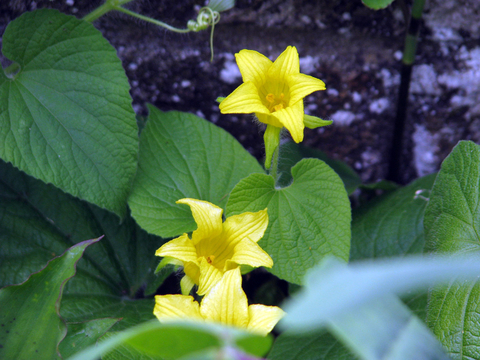Quick facts
Red hailstone (Thladiantha dubia) is a species of concern in Minnesota because it is spreading invasively.
- It is an herbaceous vine that grasps other plants and objects for support, growing up to 18 feet per year.
- It is found growing over forest edge vegetation, causing it to look like a blanket of vines.
- Please report this species so we can better understand its distribution in the wild.
Red hailstone, also called golden creeper gourd or Manchu tubergourd, is showing invasive tendencies in Minnesota. It is an herbaceous vine, covered in downy hooked hairs with tendrils that grasp other plants and objects for support, growing up to 18 feet per year.
It commonly grows in degraded landscapes, along railroad corridors, in cornfields and in eroded floodplain forests. In Minnesota it has been found growing over other vegetation, including shrubs and small trees, causing it to look like a blanket of vines draped over the forest edge.
How to identify red hailstone
- Stem: One or more arching, hairless flower stalks form from the center of the rosette.
- Leaves: Fine, simple, heart-shaped, irregularly toothed and arranged alternately with petioles up to 2 ½ inches long.
- Flowers: It is dioecious, meaning there are different male and female plants. From July-September it has conspicuous bell-shaped yellow or golden flowers with five petals fused at the base producing a tube.
- Seeds: Both male and female plants must be present to produce fruit. Fruits are up to 2 inches long, green-yellow, orange or reddish and are fleshy, oblong, hairy and have vertical stripes. Each fruit produces seeds that are dark brown and resemble watermelon seeds.
- Roots: The potato-like tuberous underground stems are perennial, meaning they overwinter and produce new growth each season.
Common look-alikes
- Wild yam (Dioscorea villosa) is a native plant that has clusters of small stalkless green to white flowers and heart-shaped leaves. However, wild yam leaves have deep veins radiating from the base and the fruit is a 1 inch broadly-winged 3 section fruit with 2 seeds inside.
- Many different types of common garden vine plants such as morning glories, or vegetables like cucumber, zucchini and yellow squash are grown in Minnesota.
Reporting and controlling red hailstone
Report findings of non-native species found in unmanaged areas using one of the following methods:
- Use the Great Lakes Early Detection Network (GLEDN) free mobile app (preferred).
- Report using the EDDMapS Midwest web-based mapping system for documenting invasive species.
- Contact the Minnesota Department of Agriculture's Arrest the Pest program via email at arrest.the.pest@state.mn.us or call 1-888-545-6684.
Reviewed in 2021


